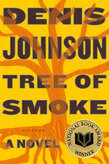By Kevin Rabalais
Whenever I find myself growing dissatisfied, it isn’t long before I start to point a finger at the nearest stack of books. The symptom is always the same: after fifteen or fifty pages, I toss them aside with the full knowledge that the failure may be mine, this inability to meet expectations. Weeks, sometimes months, pass before I can define the problem. It’s something primal, a longing that’s easier to describe to an addict than someone who doesn’t recognize literature as a lifeline. Then, at some point inside this spiral, I remember Nabokov’s advice: only the rereading counts. So I go back, in my moments of doubt and hunger, to the books that consistently exceed my expectations. And I go back, often, to the work of Denis Johnson, the American poet, short story writer and novelist born on this day, July 1, in 1949.
Read Johnson’s pages and experience a fever dream. His books burn with the urgency of poetry. Consider a moment in “Work,” one of eleven linked stories in Jesus’ Son, when the nameless narrator sits down at a bar and sees his favorite bartender:
Who should be pouring drinks but a young woman whose name I can’t remember. It was like doubling your money. She wasn’t going to make her employees rich. Needless to say, she was revered among us. …
‘Nurse,’ I sobbed. She poured doubles like an angel, right up to the lip of the cocktail glass, no measuring. ‘You have a lovely pitching arm.’ You had to go down to them like a hummingbird over a blossom.
Johnson died in May 2017. We greet a favorite writer’s death with selfish despair. In place of expectation and sustenance comes unbearable silence, the absence of a voice we would follow into the desert, knowing we will reach the other side, saved. Johnson left us with a significant shelf to read and reread. This includes nine novels, among them a National Book Award winner, Tree of Smoke; two story collections (one, The Largesse of the Sea Maiden, published posthumously, the other, Jesus’ Son, among the most influential of the past quarter century); five volumes of poetry; and an under-appreciated book of reportage, Seek, which belongs next to the best of Ryszard Kapuscinski and Joan Didion.
With unflinching precision, Johnson examined the dislocated, the dispossessed, the damned. His characters plunge to the depths of the fallen world because to deny themselves any human experience seems, well, inhuman. It’s as though they all have the Roman playwright Terence’s dictum—“I am a human, and I think nothing of which is human is alien to me”—tattooed on their forearms.
“How could I do it, how could a person go that low?” Johnson writes in the final story of Jesus’ Son. “And I understand your question, to which I reply, are you kidding? That’s nothing. I’d been much lower than that. And I expected to see myself do worse.”
Every Johnson aficionado has a favorite among the writer’s body of work. I’ve never heard anyone else position mine, The Stars at Noon, at the summit, but it’s this one, Johnson’s third and most under-appreciated novel, that I open more than any of the others, the book I reach for in times of need.
Wanting to go deeper, perhaps, than any of Johnson’s other characters, the nameless narrator of The Stars at Noon travels to Nicaragua during the country’s civil war because, she says, “I wanted to know the exact dimensions of Hell.” At 181 pages, The Stars at Noon is Johnson at his best, a novel of brilliant conception and execution. The characters who populate this world (it’s set in “the Inferno, 1984”) are barflies and spies, journalists, prostitutes, soldiers and government officials. Few are what they claim. They collide in a chaotic landscape.
“I don’t know at what point, maybe it’s as you pass the second or third miserable sugar refinery looking just like a prison, that you realize you’ve been ejected from Paradise,” Johnson writes in the voice of his American narrator who calls herself, at times, a journalist, at others, a prostitute. She’s half-hearted in her attempts to inhabit either of those worlds but fully in danger of having her visa revoked. She received money on one lone occasion from a magazine editor who now disdains her, so there’s no hope of renewing her press credentials. Rather than leave for Costa Rica or America, she advances headlong into the novel’s increasingly nightmarish world. “We can’t remember our sins here,” she says. “We don’t know who we used to be.”
Others view her with suspicion, among them the local who says to (and about) her, “Watch out for the woman who drinks when she’s not thirsty.” Like the majority of Johnson’s characters, she burns through life. He populates his books with those who fear an existence in which their animal urges and pleasures become meaningless. Late in The Stars at Noon, for instance, Johnson describes the unfulfilled gratifications of a man who finds himself inept in Eden as those of “The speechless poet, the blind painter—a tingling in the sculptor’s amputated hands.”
The narrator meets an Englishman. He inquires whether she’s for hire. They begin an awkward romance. He sells secrets from one Central American government to another. Soon, they find themselves on the run. The plot, like most Johnson novels, gets messy, but we don’t read Johnson for tidiness.
Epigraph from Denis Johnson’s The Stars at Noon.
“It’s not enough to observe,” Johnson writes in The Stars at Noon. “It’s never enough to observe suffering.” And, elsewhere in the novel: “Poets who live in Hell go to Heaven when they die.” Like his characters, Johnson lived and worked with his demons, struggling with but ultimately overcoming various addictions. He offered his visions up to us not as a warning but in an attempt to do what literature has always done better than any other art: to shock us into new forms of awareness as it allows us to comprehend all that our own limited lives will never permit.
Banner image: Detail from the Walter Anderson Museum of Art, Ocean Springs, Mississippi. Photograph by Kevin Rabalais.
To receive updates from Sacred Trespasses, please subscribe or follow us on Twitter.










